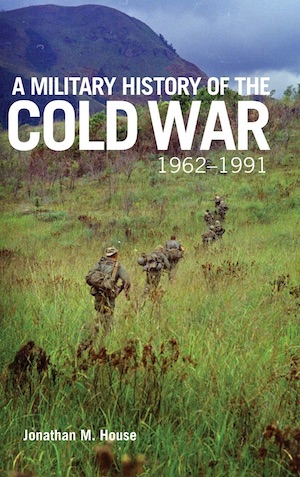By Benjamin Franklin Martin
Of the confrontation between the United States and the Soviet Union, Russians used to joke: “There will be no war, but in the struggle for peace not a stone will be left standing.” There was indeed no war, but only their stones collapsed.
Because a direct encounter in Europe between the two superpowers threatened the use of nuclear weapons and likely “mutual assured destruction,” each sought political advantage through limited military engagements in Africa and the Middle East. Their efforts were largely frustrated by the difficulty of controlling their allies or proxies and by the realities of resources, terrain, and distance. Hard lessons these were, but leaders in first the United States and then the Soviet Union ignored them when intervening in Asia, Vietnam, and Afghanistan, respectively. The account of these “Cold War” years by Jonathan M. House presents a cautionary tale to anyone imagining that the projection of military power can be either simple or without grave risk.
The material on the American experience in Vietnam is a litany of failures. The Gulf of Tonkin resolution, the basis for escalating United States involvement, was based on “dubious” reports. The South Vietnamese army was “corrupt” and by 1965 suffering 7,000 desertions a month. The unit cohesion of American units was undermined by rapid turnover from one-year deployments. Draftees were often recalcitrant soldiers and by 1967 represented 33 percent of combat deaths. When the decline of ROTC programs led to a lack of junior officers, enlisted men were commissioned who “proved woefully ineffective and amoral”—the reference is to the My Lai massacre. Well-trained reserve and National Guard units were not mobilized for fear of political consequences. The American commander, General William Westmorland, committed “the error of trying to apply conventional firepower to an unconventional war.” The Tet Offensive of early 1968 was a costly failure for North Vietnam, which overestimated its popular support in South Vietnam, but among Americans, it appeared to prove the fighting stalemated.
Even before the United States withdrew from Vietnam, its leaders pursued a policy of détente with the Soviet Union. For the United States, the Vietnam experience had reduced its willingness to act overseas, and economic stagflation had compromised its ability to do so. The Soviet Union was a willing partner because of its own struggling economy and because of “reduced ideological fervor.” The United States used this period of calm to prepare a renewal of strength through precision guided missiles, stealth technology, and a far better-trained, more proficient all-volunteer army.
By contrast, the Soviet Union tried unsuccessfully to match the new weapons technology while also being unable to assuage its growing problem of restive satellite states, combined with ethnic, nationalistic, and religious unrest: the disaster at Chernobyl and its aftereffects were the symbol of its failures. In this context, the decision by Soviet leaders to send troops to Afghanistan was foolhardy. Disregarding the mistakes made by the United States in Vietnam and thereby repeating them was worse. But worst of all was failing to recognize that the intervention would exacerbate every one of its underlying problems.
House insists, “By itself, the Afghan conflict was not fatal to the Soviet Union.” But the Afghan conflict may well have been the tipping point toppling the stones. However much Americans like to claim victory in the Cold War, the truth may be closer to the words of Soviet Deputy Foreign Minister Alexander Bessmertnykh in 1990: “It’s not they [the Americans] who have destroyed it [the USSR] but we ourselves.”
Benjamin Franklin Martin (ΦΒΚ, Davidson College) is Price Professor of History Emeritus at Louisiana State University; his most recent book is Roger Martin du Gard and Maumort: The Nobel Laureate and His Unfinished Creation (2017).




